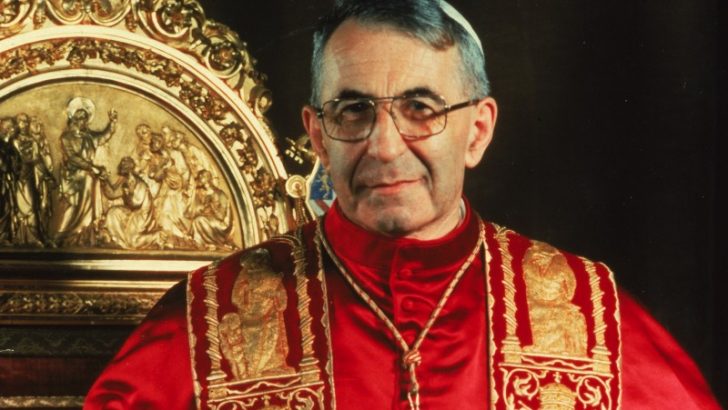While the Vatican assesses potential miracles attributed to the intercession of Pope John Paul I, a new books sheds light on events surrounding his death, writes Michael Kelly
It’s no coincidence that Dan Browne – author if The Da Vinci Code and Angels and Demons – chose the Catholic Church as the backdrop for his books. A combination of intrigue with the mysteries of the faith and a preoccupation with secrecy, Catholicism provides fertile ground for the imagination.
The extent to which people will believe outlandish things about the inner workings of the Church speaks to the extent of the ignorance that often exists about the Church in the public imagination – particularly of non-Catholics. This is particularly true of the Vatican which often appears impenetrable to the outside world.
Take the case of Pope John Paul I, for example. Cardinal Albino Luciani had been Pope for only 33 days when he was discovered dead in his apartment in the Apostolic Palace at the Vatican. The fact that the Pontiff was aged only 65 at the time of his death in September 1978 did little to dampen speculation that he met a grisly end.
Enemies
Rumours swilled around of a masonic plot at the heart of the Apostolic See. Others saw alleged reforms at the Vatican Bank as enough to provoke enemies of the man who became known as ‘the smiling Pope’.
The story provoked considerable interest in Ireland at the time given that one of the Pope’s closest collaborators with Irishman Msgr John Magee (later Bishop of Cloyne).
A new book reveals that the truth of the situation is more sober than the wildest of the speculation, showing that the Pope had in fact been ill the evening before his lifeless body was discovered. Unfortunately, it seems that John Paul – along with everyone else – underestimated the seriousness of his situation.
The journalist Stefania Falasca in her new book Papa Luciani: Cronaca di una morte (Pope Luciani: Chronicle of a death) published this week sheds light on never before seen evidence.
With a preface written by Vatican Secretary of State Cardinal Pietro Parolin, the book she has questioned witnesses and has had access to Vatican files on the case as well as the late Pope’s own medical records.
One of the witnesses is Sr Margherita Marin, now 76 years old, at the time she was the youngest of the Venetian nuns working in the Pope’s private residence. According to the book, it was Sr Margherita who entered the bedroom of John Paul I at dawn on September 29, 1978, immediately after Sister Vincenza Taffarel, the elderly religious who had been assisting Luciani for over 20 years.
She was the one who witnessed for the first time what happened in the hours prior to the sudden death of the Pope. She denies that he was fatigued if not crushed by the burden of the new responsibility s has been claimed by some. “I have always seen him calm, serene, full of trust, confident”. She insists that he did not follow any particular diets and that he was eating what the others ate.
She recalls the last hours of the Pontiff’s life. “I was ironing in the wardrobe with the door open and I saw him walking back and forth. He was walking in the apartment holding some papers he was reading…I remember him seeing me ironing and saying, ‘Sister, I make you work a lot… don’t bother ironing the shirt so well because it’s hot, I sweat and need to change them often…just iron the collar and wrists, that the rest is not seen, you know…’”.
From another of the witnesses, the Pope’s assistant Angelo Gugel, some light is shed on the sudden illness that the Pope had that evening, just before dinner, while praying with Msgr Magee.
It is all described in a document drawn up in the days after his death by Prof. Renato Buzzonetti – the first doctor to be called to the bedside of the dead Pope.
In the detailed report addressed to the Secretariat of State on October 9, 1978, Prof. Buzzonetti spoke of an “episode of pain localised at the third superior of the sternal region, suffered by the Holy Father around 7.30pm on the day of death. The episode lasted for more than five minutes, and occurred while the Pope was seated and intent on the recitation of evening with Msgr Magee and it regressed without any therapy”.
Testimony
In his testimony, Msgr Magee claims that no-one informed Sr Vincenza – who was a nurse – about the episode. According to Msgr Magee, it was the Pope himself who insisted on no fuss and didn’t want a doctor to be called. It was only the following morning in the presence of the dead Pope that Prof. Buzzonetti was made aware of the sudden bout of illness the evening before.
Ms Falasca‘s book, thanks to the new testimonies, brings to light some contradictions in the stories of the two secretaries of the Pontiff/ Fr Diego Lorenzi, the priest who had followed Luciani from Venice, was not present at the time when the Pope had the chest-pain in the chapel. And on the evening of September 28, immediately after dinner, he left the apartment.
On the morning of September 29, it was not the secretaries who found the body of the Pope, but Sr Vincenza and Sr Margherita. The Pope had not touched the coffee that had been left for him in the sacristy at 05.15, and so Sr Vincenza after knocking several times, entered the room and said, “Holiness, you shouldn’t joke with me!”
“Then she called me, coming out shocked,” Sr Margherita recounts, “I immediately went in and saw him too…I touched his hands, they were cold, I saw, and I was struck by my his slightly dark fingernails”.
Among the unpublished documents in the book are the medical records from which it can be seen that already in 1975, during a hospitalisation, a minor cardiovascular pathology was reported, that was treated with anticoagulants and considered resolved.
And there is also the note that the cardinals before the new conclave that would elect Karol Wojtyla, wanted to address in complete secrecy to the doctors who had dealt with John Paul I on the occasion of the embalming. Through the Secretariat of State, the cardinals asked if “the examination of the body” allowed to “exclude traumatic lesions of any kind”; if the diagnosis of “sudden death” was ascertained and finally they asked if “Sudden death is always natural”. These were, the book asserts, serious and significant doubts: with the cardinals not excluding a priori the hypothesis of a caused death. However, the doctors insisted this was not the case.
The new book comes as it is reported that the Vatican is currently investigating two alleged miracles attributed to the intercession of the Venetian Pontiff. Many Roman observers are of the belief that the beatification of John Paul I is only a matter of time.
Of 20th Century Popes, Pius X, John XXIII and John Paul II have all been sainted. Paul VI has been beafitied while Pius XII has been declared ‘Venerable’ by the Church. In the previous century, Pius IX is the only Pope to be raised to the altars of the Church having been beatified by St John Paul II on September 3, 2000.


 Michael Kelly
Michael Kelly Pope John Paul I
Pope John Paul I 